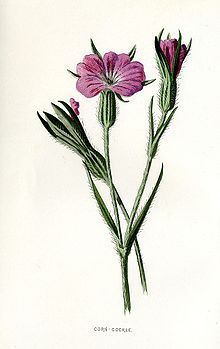Agrostemma githago

Agrostemma githago, the common corn-cockle (also written “corncockle”) is a herbaceous annual flowering plant in the pink and carnation family Caryophyllaceae.
It grows with a stem to 100 cm (39 in) long with lanceolate leaves. The flowers are up to 5 cm (2.0 in) in diameter, usually single at the ends of the stem. The sepals have five narrow teeth much longer than the petals. It has ten stamens.[1] It has slender pink flowers. It is an erect plant covered with fine hairs. Its few branches are each tipped with a single deep pink to purple flower. The flowers are scentless, 25–50 mm (1.0–2.0 in) across, and produced in the summer months – May to September in the northern hemisphere, November to March in the southern hemisphere.
Each petal bears two or three discontinuous black lines. The five narrow pointed sepals exceed the petals and are joined at the base to form a rigid tube with ten ribs. Leaves are pale green, opposite, narrowly lanceolate, held nearly erect against stem and are 45–145 mm (1.8–5.7 in) long. Seeds are produced in a many-seeded capsule. It can be found in fields, roadsides, railway lines, waste places, and other disturbed areas.
In the 19th century, it was reported as a very common weed of European wheat fields and its seeds were inadvertently included in harvested wheat seed and then resown the following season. It is very likely that until the 20th century, most wheat contained some corn cockle seed. It is susceptible to downy mildew caused by the oomycete species Peronospora agrostemmatis.[2]
